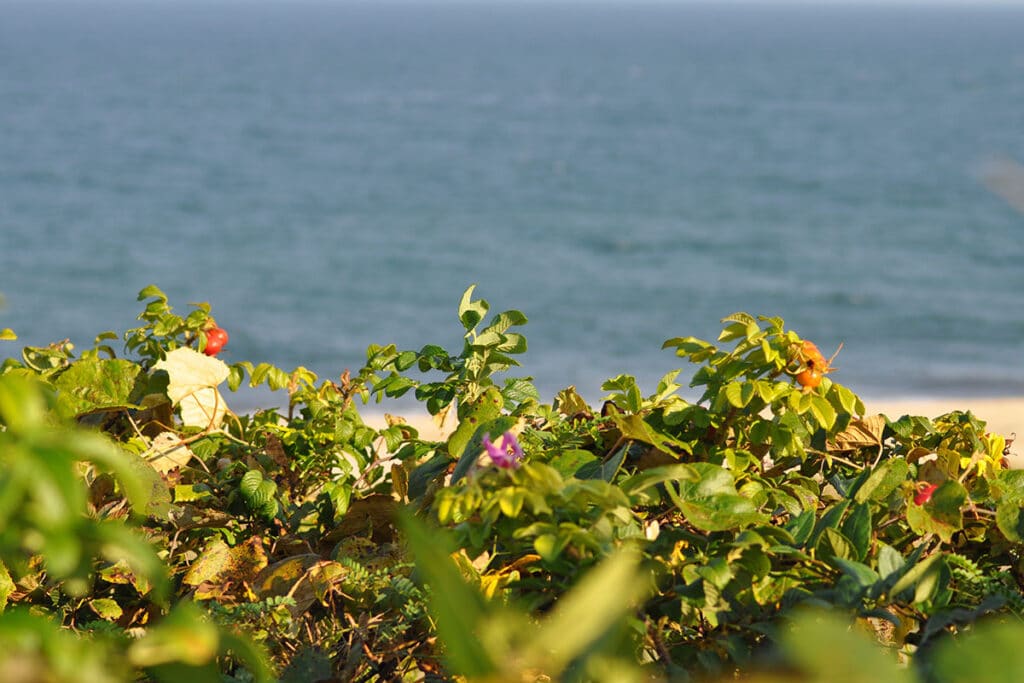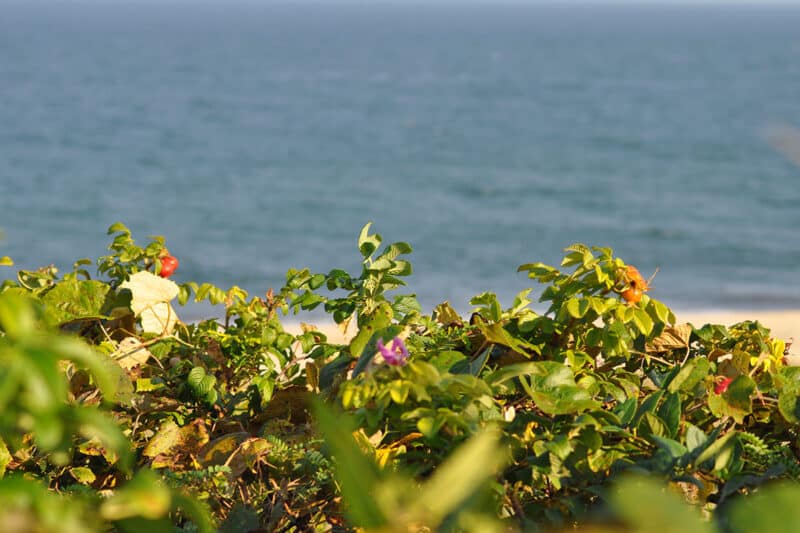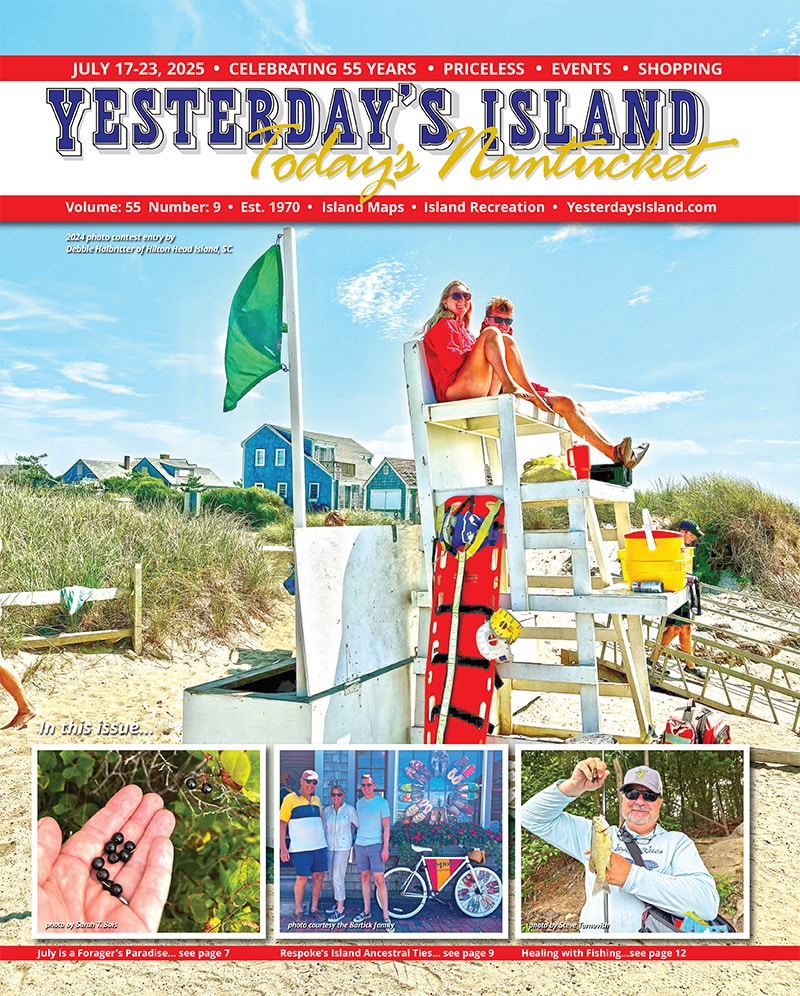by C. Oscar Olson
Before European settlers arrived on Nantucket, the island was inhabited by the indigenous Wampanoag people. They numbered in the thousands and thrived not only due to their cultivation of corn and beans, but because of the richness of the environment around them. With the convenience of mass production and modern agriculture, it’s easy to forget about these prolific plants and wild foods that sustained humans for countless generations. There’s a bounty to be had in your back yard and beyond: the key is to know what you’re looking for. There are lots of locals who take full advantage of the forests and fields, sands and seas, and Nantucket’s Seth Engelbourg is one of them.
A trained ecologist with a masters in Environmental Education, Seth works with the Linda Loring Nature Foundation as a naturalist educator and program manager. Passionate about the hobby and a natural side of New England, he has some important advice for beginning foragers: “You should never eat anything from the wild that you are not 100% sure of. It is best to start with a trained mentor and a handy guidebook.” He recommends Wild Plants I Have Known… and Eaten by Russ Cohen, an award winning author, environmentalist, and Massachusetts native. The book focuses on New England and is the perfect companion to both beginners and experts. There are also digital tools like GoBotany, curated by the Native Plant Trust, which features a vast collection of photos and facts on New England’s native plants at gobotany.nativeplanttrust.org.
Though his list is long, much of what Engelbourg is after varies in availability from season to season and from year to year. “The nice thing about many of these foods is that they’re available throughout different times of the year,” he says, “in seasons when I’m feeling ambitious, I’ll make a harvest calendar.” Compared to the mainland, things tend to ripen later in our cooler climate, and some don’t stay ripe for very long, meaning flexibility is necessary with your estimations.
Since nearly half the island is set aside as conservation land, there are lots of places to look. Wild fruits are probably the easiest place to start your foraging fun. Blueberries, huckleberries, and fox grapes are common and can be enjoyed raw or in preserves, pies, sauces, and more. Though the flavor of the Fox Grape is considered to be too potent for wine making, they are nice for a nibble on your hike, preserving in jams and jellies, or juicing. These are all also delicious in sweet sauces and reductions. Fresh grapes freeze well and the leaves are edible, too. Try them in salads to enjoy their bitter, citrusy flavor, or blanch some for your own homemade Dolma.

Rose hips, abundant island wide, are hard to the touch and tart on the tongue. It is estimated that contain 4 to 40 times the the vitamin C as in oranges and have been used for centuries as a natural remedy to a number of ailments, including scurvy on long whaling voyages. From preventing and treating colds, stomach issues and intestinal diseases, weight loss, high blood pressure, even topically on stretch marks, they are truly a super-food.
Though it is most commonly found dried in teas, the cranberry-like flavor of the rose hip has many other applications in the kitchen. They make for a brightly flavored spread not unlike marmalade, sweet and versatile syrups, even rose hip ice cream and rose hip wine. They are also fine to eat raw, though most folks find them unpalatable. Seth’s favorite application doesn’t involve the fruit, but the petals from the rose-like flowers that produce them. “I usually make rose flower syrup with the petals, but also eat them raw, add to salads, or dry and add to salt.” Their delicate, floral, fruity flavor adds an alluring aroma to everything. You can see this and other foraging recipes by Seth at YesterdaysIsland.com
For a fun flavor close to home, keep an eye out for garlic mustard. Recognized by its white flowers in mid-May, it becomes bitter as the weather warms. This weed is as invasive as it is abundant, and its mild garlic aroma makes for a wonderful pesto or a nice addition in salads. Dandelions are hard to miss as well, and you can eat the flowers and leaves raw or soften them up in a sautee. Seth infuses olive oil or butter with sheep’s sorrel for its mild lemony flavor.
Exercise extreme caution when venturing out to find food. Many plants have lookalikes that can cause illness or worse, so unless you’re absolutely certain that you’ve found what you’re after, do not eat it. Many wild plants are packed with poisons, and some edible plants have poisonous parts. One of Engelbourg’s favorites is the black cherry. Also known as rum cherry or mountain cherry, this species is bittersweet in more ways than one. Englelbourg warns, “though the fruit is edible, the pits, twigs, bark, and leaves all contain cyanide,” a toxin deadly to humans and animals alike. Seth uses the fruit to make black cherry soda by fermenting them into a sparking probiotic. They can also be used to make jams, jellies, sauces, and pies.
There’s no reason to limit yourself to the land. Our oceans and shores are rich with food, and much of it can be gathered from the coast. Sea beans, technically succulents, are a crispy, briny delight. They grow in the salty soil above the shoreline from spring to fall and are commonly found in salt flats and marshes. Found on the menu in a many an island restaurant, they’re delicious sautéed or in salads. Shellfish are also abundant in our waters, “I fish for scallops, blue mussels, and dig for quahogs and steamers locally,” Englelbourg adds.
Family bay scallop season started on October 1 and continues through March 31. With a family permit from the Town of Nantucket, you may harvest up to one bushel per week, scalloping Wednesday through Sunday. Make sure each scallop you gather has a well-defined growth ring.
Mushrooms are at the top of many foragers’ lists, and they can also be the most dangerous. But when properly identified, these meaty morsels can be made the star of any entree. Seth seeks out the rare but coveted morel, sometimes found scattered along the edge of forests. His fungi hunts also include puffball mushrooms and king bolete, and just once he came upon hen of the woods. These polypore mushrooms can be found growing on trees, usually oaks, and are named because of their resemblance to chicken in both appearance, taste, and texture.
Amazingly, this list of wild wonders is just the beginning for finding wild food on Nantucket. “There are many other local wild edibles that I have sampled at one point or another,” Engelbourg recalls. “It’s a lifelong journey, but connecting to your wild food resources is a beneficial endeavor.” Foraging can provide an exciting new connection with the wilds around us, and I, for one, can’t wait to start exploring. There are a few things to be careful of while on your food finding missions. Always avoid trespassing on private property. Instead, stick to public land or conservation areas that are open to the public, and get permission when you might need it. Take measures to protect yourself from ticks and other biting bugs, too. Though DEET is a tried and true repellant, there are a growing number of all natural sprays and lotions proving to be just as effective. And remember to watch where you walk. Poison ivy is prevalent on the island, and much like the plants you are searching for it can often be hiding in plain sight. Lastly, it is of the utmost importance to keep your harvesting ethical. Never take everything from one plant or one area. Engelbourg closes: “taking just a bit from multiple plants or places ensures that resources remain available for reproduction and wildlife.”
Rose Petal Syrup
One of Seth Engelbourg’s recipes for foragers
2 cups fresh rose (Rosa rugosa) petals
1 cup water
1 cup white sugar
- Ethically harvest at least 2 cups of fresh rose petals.
Ensure that you have permission of the landowner to
forage. Gather petals in a way so that you only remove
a few flowers from each plant, while allowing the majority
to stay in bloom. This helps preserve the resource
for pollinators and maintains the plant’s ability
to fruit/reproduce. - Rinse petals in clean water and let dry.
- Prepare a 1:1 simple syrup with the water and sugar
in a saucepan. Once the sugar dissolves reduce heat to
a simmer. - Add in rose petals and cook for 10 minutes. Remove
from heat and allow the mixture to steep for 10 additional
minutes. - Strain the syrup through a fine mesh sieve into a
glass jar or bottle and let cool. - Store in fridge for up to one month.
Fox Grape Fruit Leather
One of Seth Engelbourg’s recipes for foragers
4 cups wild fox grapes
2 Tbl raw honey (preferably produced locally)
1 Tbl lemon juice
- Ethically harvest at least 4 cups of wild fox grapes.
- Ensure that you have permission of the landowner to forage. Gather grapes in a way so that you only remove a few fruits from each plant. This helps maintain the plant’s ability to reproduce.
- Preheat your oven to 200°F. Line a baking sheet with parchment paper and set aside.
- Rinse grapes in clean water and let dry.
- Cook down grapes in a large stockpot, and mash with a potato masher to separate the juice/pulp from the skins and seeds.
- Strain grape mixture through a mesh sieve to remove skins and seeds.
- Transfer juice and pulp back into the pot and add honey and lemon juice.
- Stir and simmer over medium heat for 10 minutes or so until mixture is moderately thick but less so than a jam.
- Pour mixture onto previously prepared baking sheet and spread into a thin layer.
- Bake for about 4 hours until the mixture is no longer tacky in the middle and the leather is slightly translucent but darkened in color.
- Allow to cool completely.
- Cut fruit leather (with parchment paper attached) into strips and then roll each strip up tightly.
- Enjoy immediately or store in an airtight container in the refrigerator for up to five days.



